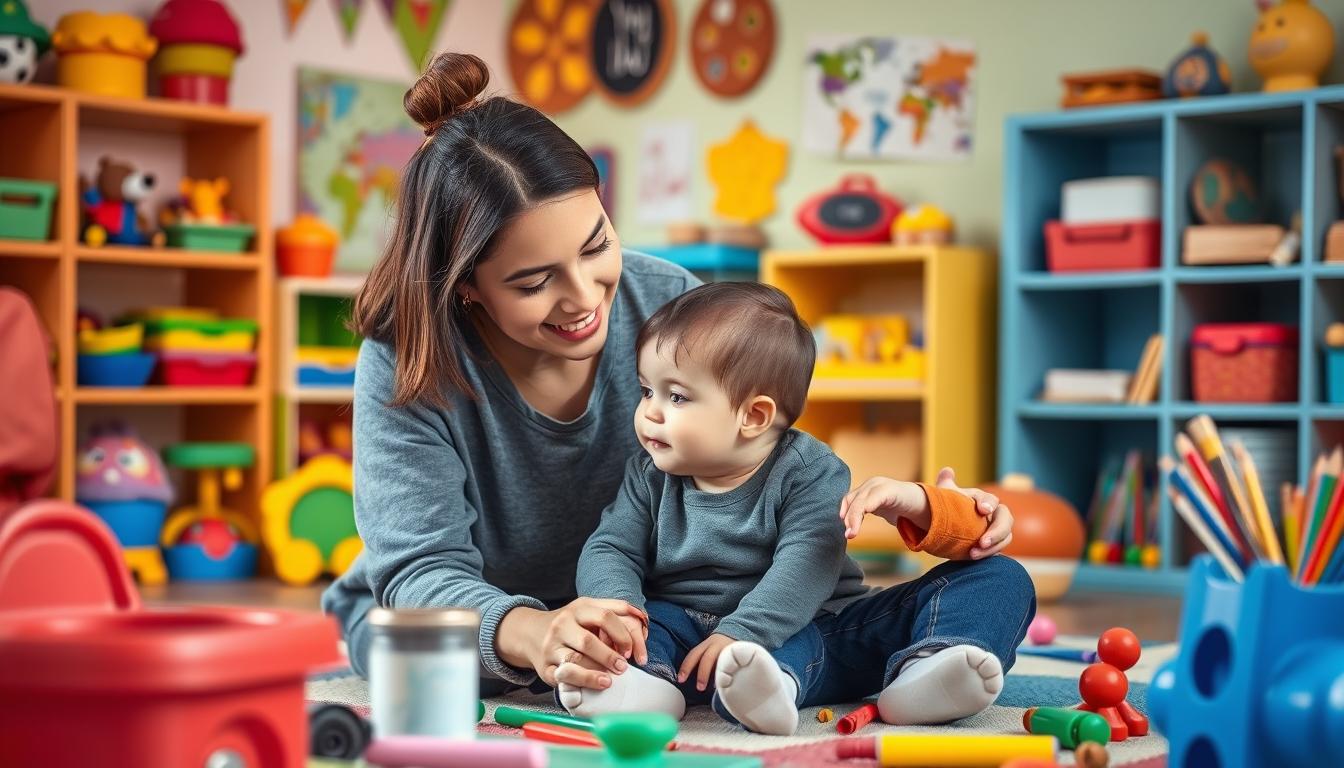Handling the “terrible twos” can be tough for parents. But, with the right strategies, this stage can be managed with patience and positivity. This guide offers expert advice to help parents deal with toddler tantrums and support their child’s growth.
It covers the reasons behind common behaviors, managing meltdowns, and encouraging positive development. With these tools, parents can thrive during this critical phase.
Contents
- 1 Understanding the Terrible Twos Phase
- 2 The Role of Development in Behavior
- 3 Setting Realistic Expectations for Parents
- 4 Strategies for Managing Tantrums
- 5 Positive Reinforcement Techniques
- 6 Effective Communication with Toddlers
- 7 Creating a Supportive Environment
- 8 Using Time-Outs Constructively
- 9 The Importance of Patience
- 10 Seeking Professional Advice
- 11 Engaging with Your Toddler’s Interests
- 12 Conclusion: Embracing the Journey
- 13 FAQ
- 13.1 What are the “terrible twos”?
- 13.2 What are some common behaviors associated with the terrible twos?
- 13.3 Why is the terrible twos stage important for a child’s development?
- 13.4 How can parents set realistic expectations during the terrible twos?
- 13.5 What strategies can parents use to manage toddler tantrums?
- 13.6 How can positive reinforcement techniques help during the terrible twos?
- 13.7 What communication techniques are helpful when interacting with toddlers?
- 13.8 How can parents create a supportive environment for toddlers?
- 13.9 When and how should parents use time-outs effectively?
- 13.10 Why is patience so crucial during the terrible twos?
- 13.11 When should parents seek professional advice for their toddler’s behavior?
- 13.12 How can parents engage with their toddler’s interests to promote positive behavior?
Key Takeaways
- Understand the developmental factors behind the “terrible twos” to better address behaviors
- Implement strategies for managing tantrums, such as using distraction and creating a calm environment
- Leverage positive reinforcement to encourage good behavior and establish consistent routines
- Communicate effectively with toddlers by speaking their language and practicing active listening
- Cultivate patience and self-care as parents navigate this challenging yet rewarding stage
Understanding the Terrible Twos Phase
The “terrible twos” can make many parents nervous. But what are the terrible twos, and why are they so important in a child’s life? Let’s look into this key time in a child’s growth.
What Are the Terrible Twos?
The terrible twos happen when a child, usually between 18 and 24 months, starts to want to do things their way. This can lead to tough behaviors like throwing tantrums, being stubborn, and not listening to parents.
Common Behaviors to Expect
Parents might see many behaviors during the terrible twos, including:
- Frequent tantrums and meltdowns
- Saying “no” to everything
- Difficulty sharing or taking turns
- Aggressive behaviors like hitting, biting, or pushing
- Trouble with transitions and changes in routine
Why Is This Stage Important?
The terrible twos are tough for parents, but they’re vital for a child’s childhood development. It’s when toddlers start to be independent, show their feelings, and find out who they are. By being patient and understanding, parents help their child learn important skills for life.
“The terrible twos are a natural part of a child’s development, as they learn to navigate the world and assert their independence.”
The Role of Development in Behavior
As children grow, their skills in thinking, feeling, socializing, and speaking change a lot. These changes deeply affect how they act and interact with others. Knowing about toddler development helps parents deal with the “terrible twos” better.
Cognitive Growth in Toddlers
Toddlers’ thinking skills grow fast. They start solving problems, remembering things, and understanding cause and effect. But, when they can’t get what they want, they might get upset. This can lead to the tough behaviors seen in the terrible twos.
Emotional and Social Development
Toddlers are figuring out emotions and how to act with others. As they feel more independent, they might act strong-willed and have trouble controlling their feelings. Teaching them to manage their emotions is very important for their growth.
Language Skills and Communication
Language skills also play a big part in toddler behavior. As they learn more words and how to talk, they might have trouble saying what they need. This can cause tantrums. Helping them talk more and giving them chances to practice can help with these issues.
Understanding how thinking, feeling, socializing, and speaking skills shape toddler behavior is key. Parents and caregivers can then meet the unique needs of children during the “terrible twos” stage better.

“The terrible twos are not a curse, but a crucial stage in a child’s development, filled with both challenges and opportunities for growth.”
Setting Realistic Expectations for Parents
Dealing with the “terrible twos” can be a wild ride for families. It’s key for parents to set realistic goals and see this stage as a learning journey.
Accepting the Challenges
The terrible twos bring tantrums, defiance, and a strong will in toddlers. It might feel tough, but these behaviors are part of growing up. Parents who accept these challenges can handle them better with patience and understanding.
Embracing the Learning Process
The terrible twos are a chance for both kids and parents to learn. It’s a time to find ways to handle terrible twos and grow closer. By diving into this learning, parents can understand their child better and appreciate their unique traits.
Remember, the terrible twos won’t last forever. With the right mindset, parents can get through this stage. By focusing on their child’s growth, parents can come out stronger and more united.
“The terrible twos are not a reflection of your parenting skills, but a natural phase of your child’s development. Embrace the challenges and learn together.”
Strategies for Managing Tantrums
Dealing with toddler tantrums can be tough for parents. But, with the right strategies, you can handle it better. Knowing what triggers tantrums and how to keep things calm is crucial.
Identifying Triggers
The first step is to find out what usually causes tantrums. Look for patterns like:
- Hunger or tiredness
- Getting frustrated with something
- Changes, like bedtime or leaving a fun activity
- Too much noise or sights
Knowing these triggers helps you prevent or lessen tantrums.
Using Distraction Techniques
When a tantrum starts, distractions can help. Try these methods:
- Give them a new toy or activity
- Sing a song or dance to make them smile
- Change the scene, like going outside
- Offer a healthy snack or drink
Stay calm and guide them to something better.
Creating a Calm Environment
A calm place can also help. This means:
- Less noise and fewer distractions
- A comfy, safe spot for them to calm down
- Use deep breathing or gentle touch
- Don’t punish or react harshly
Getting through the “terrible twos” is easier with patience and good strategies. Focus on spotting triggers, using distractions, and making a calm space. This helps your child handle their feelings better.
Positive Reinforcement Techniques
Positive reinforcement is a great way to discipline toddlers. It rewards good behavior, helping them learn and grow. This method also strengthens the bond between parents and children.
Rewarding Good Behavior
It’s important to praise your toddler for good actions. This could be sharing, listening, or speaking up. Small rewards like stickers or snacks can help reinforce these behaviors.
Give feedback right away. This lets your toddler know they did something good.
Establishing Consistent Routines
Having a daily routine is key to positive reinforcement. It makes toddlers feel safe and know what’s expected. This can prevent tantrums and encourage teamwork.
Set routines for things like meals, naps, and bedtime. This brings stability and structure to their lives.
“Positive reinforcement is a powerful tool in shaping toddler behavior. By rewarding good conduct, you can encourage your little one to repeat those desirable actions.”
Every child is different. What works for one might not work for another. Try various positive reinforcement methods to find what works best for your child.
Effective Communication with Toddlers
Dealing with toddlers can be tough for parents. But, learning to communicate well is key. By talking their language and listening, you build a strong bond. This also helps with emotional control and growth.
Speaking Their Language
Toddlers use body language and simple words to show what they need. Parents should pay attention and respond with kindness. Use simple words, repeat them, and show pictures to help them understand.
Active Listening Techniques
Good communication goes both ways. When your toddler talks, look at them, nod, and say yes. Repeat what they say to make sure you get it. Ask questions that let them share more.
Learning to talk with toddlers helps them feel safe and understood. It’s a way to support their emotional regulation and childhood development.

“The best way to have a good idea is to have a lot of ideas.” – Linus Pauling
Creating a Supportive Environment
As parents, navigating the “terrible twos” is tough. It’s key to create a supportive space. Encourage independence, make safe areas for play, and set clear rules. This helps your toddler grow and thrive during this important time.
Encouraging Independence
Toddlers love to explore and be on their own. Give them chances to make choices and play by themselves. This boosts their confidence and helps them learn to solve problems.
Designing Safe Spaces for Exploration
Toddlers are always looking to discover new things. Make your home safe for them to explore. Use safety gates and childproof your space. This lets them play freely and learn without worry.
Setting Boundaries and Rules
While independence is great, rules are important too. Set clear rules and consequences. This teaches your child important life lessons and helps them feel safe.
“Cultivating a supportive environment during the terrible twos empowers your child to navigate this stage with confidence and resilience.”
By making a caring and structured home, you help your toddler grow. They’ll learn to handle the “terrible twos” and be ready for more challenges ahead.
Using Time-Outs Constructively
Parents often use time-outs to manage the “terrible twos.” Time-outs can help manage behaviors and support growth. But, it’s crucial to use them correctly and consider other methods too.
When and How to Implement Time-Outs
Time-outs work well for behaviors like hitting or tantrums. Use them wisely and always. Experts say keep them short, 1-2 minutes, and make sure the child knows why.
Also, have a quiet place for time-outs. It should be away from distractions.
Alternatives to Time-Outs
- Positive Reinforcement: Praising good behavior helps. It encourages positive actions.
- Distraction Techniques: Changing focus to a toy can stop problems.
- Encouraging Communication: Teaching toddlers to talk can lessen tantrums.
Using different strategies helps parents find what works best for their child. This supports their growth.

“Consistency is key when it comes to using time-outs effectively. It’s important to follow through and ensure that the child understands the consequences of their actions.”
The Importance of Patience
Parenting through the terrible twos can be tough. But, patience is key. It helps parents stay calm and manage parenting challenges. It also helps kids learn to control their emotional regulation.
Techniques to Cultivate Patience
Building patience takes time and effort. Here are some ways parents can improve:
- Try deep breathing to stay calm when things get stressful.
- Remember, your child’s tantrums are normal and not a personal attack.
- Take short breaks to recharge and clear your mind.
- Get support from family or friends who can offer advice or just listen.
Mindfulness Practices for Parents
Mindfulness can also help with patience. Try these activities:
- Mindful observation: Watch your child without judgment, understanding their feelings.
- Gratitude journaling: Write down the good moments and your child’s progress each day.
- Meditation: Spend a few minutes each day focusing on your breath and calming your mind.
“Patience is not just about waiting for something… it’s about how we approach the moment.” – Zachary W. Stein
By being patient and practicing mindfulness, parents can handle the terrible twos better. This improves the relationship between parent and child, making it more rewarding for everyone.
Seeking Professional Advice
Parenting through the “terrible twos” can be tough. Sometimes, you might need help from experts. They can offer advice and strategies to manage this phase.
When to Consult a Pediatrician
Pediatricians are great for parents in the terrible twos. They can help with behavior, find causes, and give tailored advice. You should see a pediatrician if you notice:
- Persistent tantrums that disrupt your day
- Big changes in sleep or eating habits
- Issues with controlling emotions or actions
- Worries about your child’s growth or development
Resources for Parenting Support Groups
Parents can also find support in groups. These groups are a place to share, learn, and get tips for the parenting challenges of the terrible twos. Some places to look include:
- Local parenting groups
- Online forums and social media
- Classes or playgroups for parents and kids
- Workshops or classes at community centers or schools
Remember, handling terrible twos is a common issue. Getting help or joining a community can really help you through this tough time.

Engaging with Your Toddler’s Interests
Connecting with our little ones is incredibly rewarding. It’s especially true during the “terrible twos” when things can get tough. Engaging with your toddler’s interests helps bond and learn together.
Activities to Promote Bonding
Toddlers love spending time with us. They enjoy activities that spark their imagination. Reading their favorite book or playing with toys are great ways to connect. These moments can calm terrible twos behavior and strengthen our bond.
- Participate in pretend play, letting your toddler lead the way
- Sing and dance to their preferred music or nursery rhymes
- Encourage exploration of safe, age-appropriate art materials
Learning Through Play
Playtime is more than just fun. It’s key for childhood development. Use play to teach new things. Tailor activities to match their interests and help them grow.
- Introduce simple board games or puzzles to build problem-solving abilities
- Engage in outdoor activities that promote physical development and motor skills
- Encourage imaginative storytelling to foster language and communication
By engaging with your toddler’s interests, you can make the “terrible twos” easier. You’ll support their growth and development in a fun way.
Conclusion: Embracing the Journey
As you’ve navigated the challenges of the terrible twos, it’s important to reflect on the progress you and your child have made. This stage, though difficult at times, is a critical period of growth and development. Embrace the journey, and take pride in the resilience you’ve both demonstrated.
Reflecting on Growth and Progress
Look back on the strategies you’ve employed to manage tantrums, foster positive behaviors, and create a supportive environment. Recognize the small victories, such as the times when you remained calm during a meltdown or when your child successfully communicated their needs. These moments showcase the growth you’ve experienced as a parent and the progress your child has made in their emotional and social development.
Encouraging Yourself and Your Child
As you move forward, continue to encourage yourself and your child. Celebrate the milestones, no matter how small, and remind yourself that this phase, too, shall pass. Offer words of affirmation to your child, recognizing their efforts and celebrating their achievements. With patience, consistency, and a willingness to adapt, you can navigate the terrain of the terrible twos and emerge stronger, more connected, and better equipped to handle future challenges.
FAQ
What are the “terrible twos”?
The “terrible twos” is a stage for toddlers, aged 18 to 24 months. They often throw tantrums, defy rules, and want to be independent.
What are some common behaviors associated with the terrible twos?
Toddlers in the terrible twos might have tantrums, defy rules, and resist sharing. They also want to be in charge and independent.
Why is the terrible twos stage important for a child’s development?
This stage is key for a child’s growth. Toddlers start to be more independent, learn to control their feelings, and improve their communication skills.
How can parents set realistic expectations during the terrible twos?
Parents should accept the challenges of this stage. Seeing it as a learning time helps. It’s a normal part of a child’s growth.
What strategies can parents use to manage toddler tantrums?
To handle tantrums, identify what causes them. Use distractions, create calm spaces, and comfort your child.
How can positive reinforcement techniques help during the terrible twos?
Positive reinforcement works well. Reward good behavior and stick to routines. It helps shape their actions positively.
What communication techniques are helpful when interacting with toddlers?
Speak their language, listen actively, and understand their feelings. This helps in better communication.
How can parents create a supportive environment for toddlers?
Encourage independence and make safe spaces for them. Set clear rules to guide their behavior.
When and how should parents use time-outs effectively?
Time-outs can discipline, but use them wisely. Consider positive methods and emotional control too.
Why is patience so crucial during the terrible twos?
Patience is key. It helps parents handle the challenges calmly. Mindfulness can also aid in managing this stage.
When should parents seek professional advice for their toddler’s behavior?
If you’re worried about your toddler’s behavior, talk to a pediatrician. Support groups can also offer help.
How can parents engage with their toddler’s interests to promote positive behavior?
Bond and learn through play. Activities that match their interests can positively shape their behavior.

